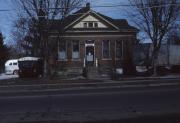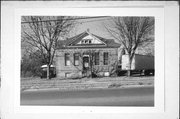| Additional Information: | A 'site file' exists for this property. It contains additional information such as correspondence, newspaper clippings, or historical information. It is a public record and may be viewed in person at the Wisconsin Historical Society, State Historic Preservation Office.
Threatened with demolition. The Kaiser Lumber Company Office is situated on the northwest corner of Menomonie St. and Tenth Avenue. This location, south of Half Moon Lake and west of the Water Street commercial district, was the site of lumber activity since the mid-1850s.
The former office building, constructed in the early years of the twentieth century, is a one story brick structure which reflects a Queen Anne influence. Resting on a cut stone foundation, the building is covered by a hip roof featuring four shingle-covered dormers capped by broad gable roofs. The entrance is centrally located on the main facade and flanked by four segmental arch windows. Similar window openings mark the building's other facades. The entry itself is contained within a segmental arch including the door and a transom window above.
The Kaiser Lumber Company Office is historically significant for its association with the growth of the city's lumber industry. The primary force in the establishment of Eau Claire, the lumber industry was the reigning economic activity in the community during the years 1860 to 1910. Despite this prominence, few intact remnants of the industry survive. Most significantly absent are any structures relating to the actual production of lumber. Within the city the Kaiser Lumber Company Office is recognized as a lumber-related site, although the relationship between the building and the structures which originally comprised the entire complex no longer exists. (Still standing on the property are one of the company's box factories and the adjoining planing mill. These buildings have been substantially altered and today are not visually identified with the office structure.) The office building was the focal point of the Kaiser Lumber Company which was organized in 1905, the last lumber firm to be established in the city. Headed by John Kaiser, a successful lumberman who had mills and factories in Muscatine, Iowa, and Stillwater, Minnesota, the Kaiser Company combined lumber and box-making in an effort to make use of the remaining timber resource. Ceasing all production in 1939, the Kaiser Lumber Company represents the final phase of the industry in Eau Claire.
Established in 1905, the Kaiser Lumber Company occupied nearly forty six acres in the lumber district at the foot of Half Moon Lake, the former site of the Valley Lumber Company, an early and prominent lumber producer. The company, founded by John Kaiser, who emigrated from Germany to the United States in 1871, was brought to Eau Claire through the efforts of the city's Commercial Association, a booster organization that encouraged the community's continued economic growth. The new enterprise received a twenty five per cent tax rebate on its city taxes and a $4000 private subscription for the purchase of the site. (E)
The Kaiser Company property included the office, sawmills, a box factory, dry kiln, lath mill, planing mill, power plant, and yards. It was supplied with logs, generally hemlock and hardwood, cut from the company's extensive timber holdings in Sawyer county. According to one source, the lumber concern owned 16,700 acres and held the timber rights to another 21,200 acres (C). In 1911, the Kaiser Company was shipping twenty railroad cars of lumber per day and in 1913 purchased the Daniel Shaw Lumber Company mill located west of the Kaiser site at the outlet of Half Moon Lake. The Shaw Company organized in 1874 closed in October, 1912, leaving only the Kaiser and New Dells Lumber Company operating in the city. Following the expansion, the growing company employed approximately 350 men and sawed between 150,000 and 175,000 feet of lumber daily (D).
Accompanying the production of lumber was the making of boxes which by 1917 dominated the company's operations. A new box factory, constructed in 1917 and organized separately as the Eau Claire Box and Crating Company, used the timber that could not be utilized for building purposes. Boxes were sold to large meat packing houses that shipped their products regionally and to manufacturing concerns such as the Kohler Company of Sheboygan, Wisconsin, and the Maytag Company of Newton, Iowa. Until 1924, when a fire destroyed the factory, it employed more than 200 men year round. Following the fire, the company resumed operations at their old box factory located on Tenth Avenue. In 1931, the business was sold but two years later with repeal of Prohibition and the subsequent demand for beverage cases, John Kaiser reopened his factory and produced boxes on a limited scale until his death in 1939.
2016- "The Kaiser Lumber Company office is historically significant as one of the few remaining buildings directly associated with the large-scale lumbering which was central to the economy of late nineteenth and early twentieth century Eau Claire.
A realignment of Menomonie Street in 1999 resulted in what had been the rear of the building coming to face the street.
Organized in 1905, Kaiser was the last lumber company established in the city. Headed by John Kaiser, it owned 16,700 acres and timber-cutting rights ot another 21,200 acres in the Chippewa Valley. By 1911, it shipped twenty railroad cars of lumber out of the city each day. In 1913, Kaiser purchased the Daniel Shaw Lumber Company. After this expansion, the company employed 350 men and sawed between 150,000 and 175,000 feet of lumber daily. Its Eau Claire facilities occupied 46 acres in the lumber district at the south end of Half Moon Lake and included sawmills, a box factory, dry kiln, lathe mill, planing mill, power plant and lumber yards. As a byproduct of lumber production, the company manufactured boxes utilizing timber not suitable for building purposes. By 1917, box manufacturing dominated the company's business. The cessation of production in 1939 marked the end of the final phase of the lumber industry in Eau Claire."
-"Eau Claire Landmarks: Designated Historic Properties in Eau Claire, Wisconsin", Eau Claire Landmarks Commission, P.O. Box 5148, 2016. |
|---|
| Bibliographic References: | (A) 1910 Eau Claire County Atlas.
(B) Kaiser, N. 1959. "Logs and Boxes: The John H. Kaiser Lumber Company of Eau Claire. Thirtieth Star, Vol. 4, p. 3.
(C) Barland, L. 1965. The Rivers Flow On, p. 337.
(D) Smith, J.B.. 1967. "The Movements for Diversified Industry in Eau Claire, Wisconsin, 1879-1907". MA, UW-Madison, p. 170.
(E) EAU CLAIRE LEADER-TELEGRAM 7/3/1994.
Eau Claire Leader Telegram 5/5/1999.
Eau Claire Landmarks newsletter, 1999-2000.
Eau Claire Leader telegram 8/29/2001.
Eau Claire Landmarks booklet published by the Landmarks Commission in 2002. |
|---|


